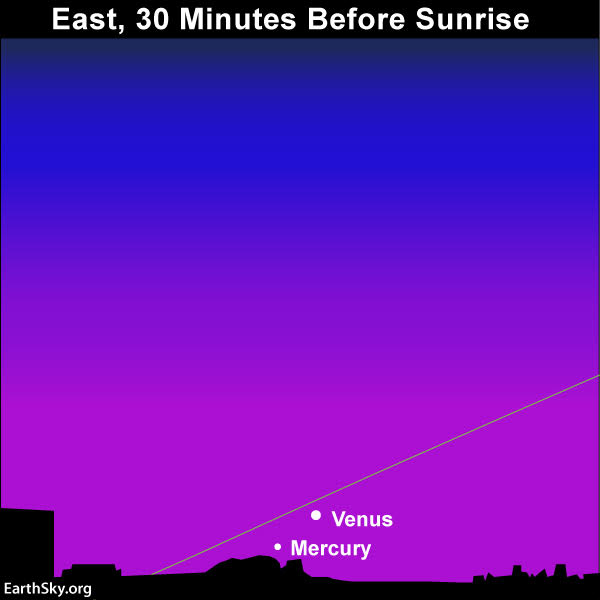Mercury Below Venus in Morning Sky
Bruce McClure in TONIGHT | April 14, 2019
No matter where you live, these next few mornings are a grand time to look for the elusive planet Mercury. For all of us, around the globe, Mercury is now below Venus – the brightest planet – in the sunrise direction, before daytime washes the pair from view. The morning of April 16, 2019, will present the closest pairing of Mercury and Venus in the morning sky for all of 2019. On that morning, these two worlds will be around 4 degrees (width of two fingers at arm’s length) apart on the sky’s dome. They’ll be close enough together to fit (or nearly fit) inside a single binocular field. So if you see Venus, but not Mercury, in the sky before sunrise, try aiming binoculars at Venus to view both planets in a single binocular field.
For the Southern Hemisphere, April 2019 showcases Mercury’s best morning apparition for the year. The planet will be easily visible to the eye alone, below Venus before sunup. For the temperate and polar zones in the Northern Hemisphere, the view of Mercury in the morning sky isn’t as good. The planet is closer to the sunrise. Use binoculars to scan for it along the eastern horizon before sunup. Then remove the binoculars and try to see Mercury with the eye alone.
From anywhere worldwide, it is to your advantage to find an unobstructed horizon in the direction of sunrise for your Mercury search. Look first for Venus – the third-brightest celestial body, after the sun and moon – to blaze mightily in your eastern sky. Then seek for Mercury a short hop below Venus. Keep in mind that Mercury follows Venus into the sky some 15 to 20 minutes after Venus first comes up. So if Venus is sitting very low in your predawn or dawn sky, chances are that Mercury has yet to rise.
Venus’ rising time varies considerably around the world. At far-northern latitudes (such as Alaska), Venus and the sun rise at nearly the same time. From mid-northern latitudes – like the contiguous U.S., Europe and Japan – Venus rises roughly an hour before sunrise. At the Earth’s equator (0 degrees latitude) Venus rises nearly two hours before the sun; and from temperate latitudes in the Southern Hemisphere, Venus rises a whopping 2 1/2 hours before sunrise. Clearly, the southerly latitudes have the big advantage in catching Mercury.
__________________________________
It was clear here today in the early morning; it was easy to see both Venus and Mercury in the eastern sky. - ilan
 |
 |
|
|||||||||||
 |
 |
||||||||||||
|
|
|
|
|
|
|
||||||||
 |
|
|
|
|
|
 |
|||||||
|
|
|
|
|||||||||||
|
|
|||||||||||||
|
|
|
|
|
|
|
|
|
|
|
|
|
|
|
Results 1 to 1 of 1
-
04-15-2019, 12:35 PM #1
Mercury Below Venus in Morning Sky
Beginner's Guide for Rocket, NFPS and IKS66...
http://iptvtalk.net/showthread.php?2...-you-should-do
Kodi Options for Rocket, NFPS and IKS66...
http://iptvtalk.net/forumdisplay.php?71-Kodi
Check the Announcement Section...
http://iptvtalk.net/forumdisplay.php...-Announcements
Similar Threads
-
Mission to Mercury, European-Japanese
By ilan in forum NASA SpaceX BoeingReplies: 0Last Post: 04-10-2020, 01:28 PM -
Mercury crossed the face of the Sun - video
By ilan in forum The Universe Closer to HomeReplies: 0Last Post: 11-16-2019, 02:37 PM -
BepiColombo mission, Venus and Mercury
By ilan in forum NASA SpaceX BoeingReplies: 0Last Post: 09-25-2019, 10:14 PM -
Moon and Venus grace eastern morning sky
By ilan in forum Maps to the StarsReplies: 0Last Post: 04-29-2019, 12:28 PM -
Mercury returns to the evening sky
By ilan in forum Maps to the StarsReplies: 0Last Post: 02-17-2019, 07:42 PM








 Reply With Quote
Reply With Quote